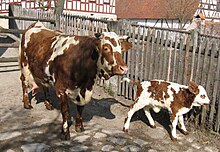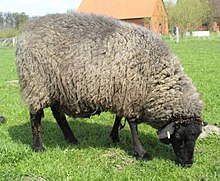Three-purpose breed
Three-purpose breed describes agricultural domestic animal breeds that are not bred one-sidedly for one performance characteristic, but combine three types of use in one animal: (1) are used as draft animals, (2) maintain the landscape through their own activities, (3) milk, wool, hides and meat deliver. In contrast to dual-purpose breeds , they are relatively rare and often threatened with extinction. Three-purpose breeds are found in sheep ( wool , milk , meat ) and cattle (milk, meat and tractive effort ).
meaning
Three-use breeds are no longer considered to be profitable in the 21st century, as agricultural production is subject to increasing specialization . Cattle as draft animals are no longer needed. This specialization began in the 18th century, when breeders such as Robert Bakewell improved local breeds, which predominantly played a role in subsistence farming , through a selective selection of qualitatively outstanding parent animals in a targeted manner to improve individual performance characteristics.
In sheep, different forms of husbandry for dairy and meat sheep have developed, which place different demands on the animal. In addition, animals with two or more breeding goals do not achieve the same performance as one-use breeds in any sub-area . Many dual-purpose breeds were originally bred as three-purpose breeds ( yellow cattle , red cattle )
Exemplary three-purpose races
-
Domestic cattle
- Ansbach-Triesdorfer
- Cachena cattle of old breeding direction
- Simmental cattle of old breeding direction
- Limpurger
- Pinzgauer
- Harz red cattle
- Murnau-Werdenfelser beef
- Randall beef
- Yellow cattle of old breeding direction
- Red cattle of old breeding direction
literature
- Christian Stockinger: "Dual-purpose breed or special breed - trend, advantages and disadvantages, forecasts." In "29. Viehwirtschaftliche Fachagung, Bundesanstalt für Alpenländische Landwirtschaft ”(conference proceedings) Gumpenstein, Irdning, April 2002
Single receipts
- ^ Robert Bakewell (1725-1795) . BBC History. Retrieved May 25, 2015.


